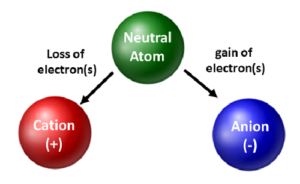Everyone I know is a big fan of at least one of these natural experiences – mountains, beaches, oceans, forests, thunderstorms, rain, waterfalls, or just an open field with lots of sunlight. Some even love more than one of these. I bet even you love at least one.
There’s something so refreshing about them, it’s almost as if you can breathe better and more freely. Maybe you’re even more relaxed, happier, or at peace.
There’s something in the air and while it may not be love, some say it’s the next best thing – negative ions.
To understand negative ions let’s have a little science lesson. I’ll try my best to make it as simple as possible.
Science 101
Everything is made up of atoms, which is in turn made up of protons, neutrons and electrons. There is an equal number of protons and electrons in an atom.
Protons have a positive charge, electrons have a negative charge, and neutrons – as you might have guessed – are neutral or have no net charge. Since there are equal protons and electrons in an atom, it is electrically neutral.
Protons and neutrons are deep inside the atom so it’s practically impossible to take them out of the atom. The electrons, can, however, move from one atom to another because they’re on the outer side and are much loosely bound.
When an electron is added or removed from an atom, the atom is now called an ion.
When you remove an electron from an atom, it’s called a positive ion, aka cation (‘cause there are more positive charges now) and when an electron is added, it’s called a negative ion, aka anion (because there are more electrons now).

Hope you’re with me till now. You can give that another read if you want.
Now that we have established what a negative ion is, we’re done with the science lesson.
Let’s get back to our favourite part – How do they impact us?
Negative ions have more positive impacts than you’d think (pun absolutely intended). In fact, they’re so beneficial that they’re also known as the vitamins of the air.
Negative ions in the air can make you feel happier, more positive and energetic. They are believed to increase levels of serotonin which helps with depression relief or stress reduction among other things.
These vitamins of air are an important part of our respiration, and an increase in their supply results in smoother respiration, hence improved metabolism which stabilises body weight (imagine losing – or gaining, as per your requirements – weight just by getting some fresh air). Not to mention that better respiration also results in improved lung function and a boost in the immune system.
Negative ions are a natural way to manage your emotions. They can help you feel less fear and nervousness, as well as lower the resting heart rate so that it’s easier for people who are trying to reduce their stress levels. They also regulate sleep patterns and the circadian rhythm.
Improvement in sleep patterns tends to enhance concentration and learning ability.
This overall progress in your health provides a feeling of wellbeingness.
Now you might think – something this beneficial has to be rare, right? Only to be found in the forest and mountains or for the lucky ones living near the beaches?
Well, well, well. It’s my pleasure to tell you that you’re absolutely wrong.
While you’re correct that they’re found in the mountains, forest, on the beach, they are not restricted to these places.
Negative ions are present during rainfall and after a thunderstorm. There are even plenty of negative ions in the sunlight and are even produced by plants. No wonder our parents emphasise so heavily to go outside for a walk.
I even have a speculation (I repeat, it’s a speculation – not evidence-based, just intuition based). The reason people have seasonal depression is that, during the colder months, we tend to stay indoors, rarely getting sunlight. This results in a drop in our negative ion levels and therefore affects our mood.
And it’s not even surprising considering fresh country air has 2,000 to 4,000 negative ions per cubic centimetre whereas on highways in rush hour or a traffic jam, the level can be far below 100 per cubic centimetre. The negative ion level for indoors is also roughly as low as 100 per cubic centimetre.
However, there’s one room in your home, indoors with higher negative ion concentrations. Guess which room is it?
Kitchen? Nope. Your bedroom? Nope again.
It’s actually your bathroom. More specifically, there’s one thing in your bathroom that creates negative ions.
That thing is your shower head. I know, pretty cool.
It has the same effect as waterfalls where water clashes with water.
Now you have no reason to not be exposed to negative ions!
Recap for memory:
- Negative ions are beneficial to our health in a number of ways, from improving our mood and sleep patterns to boosting our immune system.
- They’re present in nature, but can also be found indoors – even in your bathroom!
- So the next time you feel down, get some sun, go for a walk or just head for a shower.
P. S. I know this might not be like a typical blog post. It’s not directly related to productivity or self-improvement, but this is something that has positively affected me so much that I just had to share it with you.
Here are all the sources if you wanna do more reading 🙂
Negative Ions – The Vitamins of Air
Negative Ions Create Positive Vibes
Negative Air Ions and Their Effects on Human Health and Air Quality Improvement


[…] Taking a shower/bath, listening to all the sounds made by the water […]